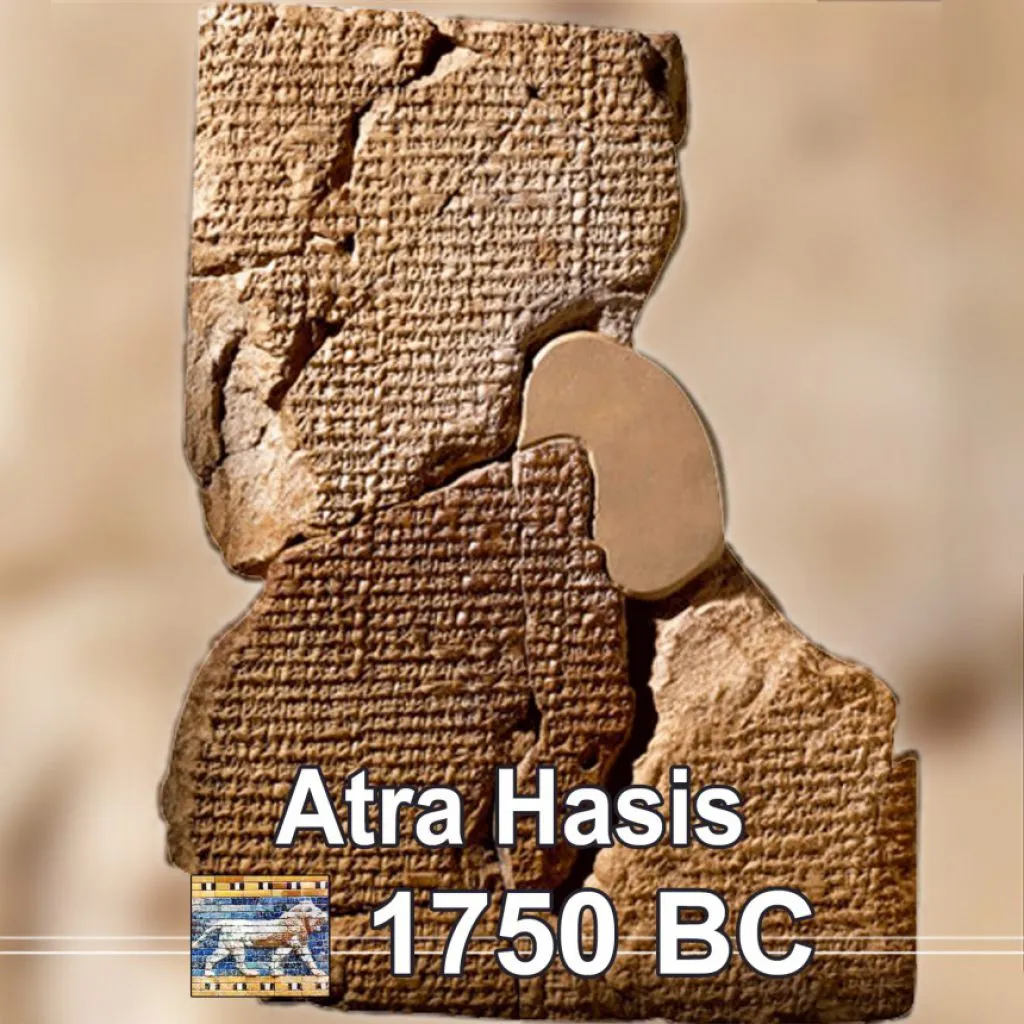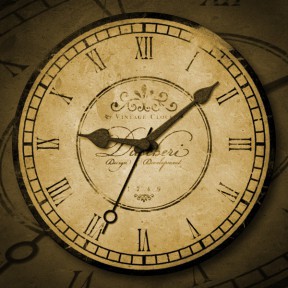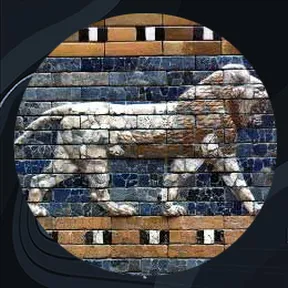
Atra Hasis
Atra-Hasis ("exceedingly wise") is the protagonist of an 18th-century BC Akkadian epic recorded in various versions on clay tablets.
The Atra-Hasis tablets include both a creation myth and a flood account, which is one of three surviving Babylonian deluge stories. The name "Atra-Hasis" also appears on one of the Sumerian king lists as king of Shuruppak in the times before a flood.
The oldest known copy of the epic tradition concerning Atrahasis can be dated by colophon (scribal identification) to the reign of Hammurabi’s great-grandson, Ammi-Saduqa (1646-1626 BC), but various Old Babylonian fragments exist; it continued to be copied into the first millennium BC. The Atrahasis story also exists in a later fragmentary Assyrian version, having been first rediscovered in the library of Ashurbanipal, but, because of the fragmentary condition of the tablets and ambiguous words, translations had been uncertain. Its fragments were assembled and translated first by George Smith as The Chaldean Account of Genesis; the name of its hero was corrected to Atra-Hasis by Heinrich Zimmern in 1899.
In 1965 Wilfred G. Lambert and A. R. Millard published many additional texts belonging to the epic, including an Old Babylonian copy (written around 1650 BC) which is our most complete surviving recension of the tale. These new texts greatly increased knowledge of the epic and were the basis for Lambert and Millard’s first English translation of the Atrahasis epic in something approaching entirety. A further fragment has been recovered in Ugarit. Walter Burkert traces the model drawn from Atrahasis to a corresponding passage, the division by lots of the air, underworld and sea among Zeus, Hades and Poseidon in the Iliad, in which “a resetting through which the foreign framework still shows”.
In its most complete surviving version, the Atrahasis epic is written on three tablets in Akkadian, the language of ancient Babylon.
SYNOPSIS
Tablet I contains a creation myth about the Sumerian gods Anu, Enlil, and Enki, gods of sky, wind, and water, “when gods were in the ways of men” according to its incipit. Following the Cleromancy (casting of lots), sky is ruled by Anu, earth by Enlil, and the freshwater sea by Enki. Enlil assigned junior divines to do farm labor and maintain the rivers and canals, but after forty years the lesser gods or dingirs rebelled and refused to do strenuous labor. Instead of punishing the rebels, Enki, who is also the kind, wise counselor of the gods, suggested that humans be created to do the work. The mother goddess Mami is assigned the task of creating humans by shaping clay figurines mixed with the flesh and blood of the slain god Geshtu-E, “a god who had intelligence” (his name means “ear” or “wisdom”). All the gods in turn spit upon the clay. After 10 months, a specially-made womb breaks open and humans are born. Tablet I continues with legends about overpopulation and plagues. Atrahasis is mentioned at the end of Tablet I.
Tablet II begins with more overpopulation of humans and the god Enlil sending first famine and drought at formulaic intervals of 1200 years to reduce the population. In this epic Enlil is depicted as a cruel, capricious god while Enki is depicted as a kind, helpful god, perhaps because priests of Enki were writing and copying the story. Tablet II is mostly damaged, but ends with Enlil's decision to destroy humankind with a flood and Enki bound by an oath to keep the plan secret.
Tablet III of the Atrahasis Epic contains the flood story. This is the part that was adapted in tablet XI of the Epic of Gilgamesh. Tablet III of Atrahasis tells how the god Enki warns the hero Atrahasis (“Extremely Wise”) of Shuruppak, speaking through a reed wall (suggestive of an oracle) to dismantle his house (perhaps to provide a construction site) and build a boat to escape the flood planned by the god Enlil to destroy humankind. The boat is to have a roof “like Apsu” (a subterranean, fresh water realm presided over by the god Enki), upper and lower decks, and to be sealed with bitumen. Atrahasis boards the boat with his family and animals and seals the door. The storm and flood begin. Even the gods are afraid. In tablet III iv, lines 7-9 the words "river" and "riverbank" are used, which probably mean the Euphrates River, because Atrahasis is listed in WB-62 as a ruler of Shuruppak which was on the Euphrates River.
After seven days the flood ends and Atrahasis offers sacrifices to the gods. Enlil is furious with Enki for violating his oath. But Enki denies violating his oath and argues: “I made sure life was preserved.” Enki and Enlil agree on other means for controlling the human population.
ATRAHASIS IN HISTORY
A few general histories can be attributed to the Mesopotamian Atrahasis by ancient sources; these should generally be considered mythology but they do give an insight into the possible origins of the character. The Epic of Gilgamesh labels Atrahasis as the son of Ubara-Tutu, king of Shuruppak, on tablet XI, ‘Gilgamesh spoke to Utnapishtim (Atrahasis), the Faraway… O man of Shuruppak, son of Ubara-Tutu’. The Instructions of Shuruppak instead label Atrahasis (under the name Ziusudra) as the son of the eponymous Shuruppak, who himself is labelled as the son of Ubara-Tutu. At this point we are left with two possible fathers: Ubara-Tutu or Shuruppak. Many available tablets comprising The Sumerian King Lists support The Epic of Gilgamesh by omitting Shuruppak as a ruler of Shuruppak. These lists imply an immediate flood after or during the rule of Ubara-Tutu. These lists also make no mention of Atrahasis under any name. However WB-62 lists a different and rather interesting chronology – here Atrahasis is listed as a ruler of Shuruppak and gudug priest, preceded by his father Shuruppak who is in turn preceded by his father Ubara-Tutu. WB-62 would therefore lend support to The Instructions of Shuruppak and is peculiar in that it mentions both Shuruppak and Atrahasis. In any event it seems that Atrahasis was of royal blood; whether he himself ruled and in what way this would affect the chronology is debatable.
























